 |
||
|
||
| ||
The material is provided by ITC Test LaboratoryUPS has a queer status on the computer market - on one hand, it is used mostly together with a PC, on the other hand, it doesn't has much of a computer inside. The IT press regard it as something relevant to their market... but not exactly of the kind. Two years ago we decided to break the tradition...The first time it was frightful but interesting, the second time it was just interesting and the third? And the third one was "it's our job and we have to do our best". Any developing test laboratory is eager to open new prospects, expand its field of activity and range of products. We were overwhelmed with that passion when we just started testing uninterruptible power supply units. Twelve... twenty three... and finally thirty six. Thirty six products from various companies are in the today's review. Due to the well-developed testing technique, tools and human resources, we were going to cover the whole local market of sub-1000 VA UPS units. However, some companies were not very enthusiastic about providing us with their samples for the tests. Well, the refusal might indicate how they estimate their chance to win. We have altered the testing technique as, on one hand, we are to provide high quality and validity of the test results, and on the other hand, this is a kind of a test conveyer well optimized for devices going through all the test stages. Testing techniqueThe today's tests deal with two groups of parameters:
For the second group of the tests we assembled a small special stand. The main problem was that the transient processes were fixed on the PC oscillographic board, and it was necessary to provide quality galvanic isolation between the measuring circuits and the tested one. In the end we got a switch with time sync circuits and two measuring channels. Coupled with an oscillograph it can fix forms of consumed current and voltage on the input and output of the UPS. 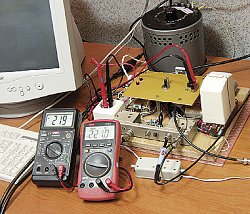 Testbed Various filtering and protection circuits were added to the stand. When calculating them, we aimed to provide the toughest protection mode with minimal deviations from true measurement values. A wide range of voltage measurements and their unpredictable character on our primary circuit and a plethora of pickups of different amplitudes and duration made us take additional measures to make the results more stable. We had to connect the on-line IMV NetPro 2000 UPS to the testbed's input where the electric mains power goes through triple transformation before going to the load, and voltage is twice stabilized and smoothed. An extremely low THD of the obtained sinusoid (2% in the tests), highly stable voltage, good impulse noise protection, low output resistance and ability to work stable on the inductive load made us sure in stability and quality of the supply voltage. In our case we connected to the output a laboratory autotransformer to control the UPS; in the no-load conditions its reactive power was 69 VoA, the active was 9 W. 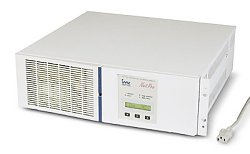 UPS IMV NetPro 2000 The oscillograms showing the changing voltage, current and power on the real computer load demonstrate that the last two oscillograms have a similar shape. Besides, it was quite a problem to get consumed power curves not at the expense of a module of multiplication of partial currents and voltages, but without special calibrated high-speed feed-through power transducers. In this case the current curve (not the voltage one) is much more informative about operation of the device. One more advantage of such procedure is that the curves obtained allow estimating more precisely the UPS's behavior both with the reactive and active character of the test load. 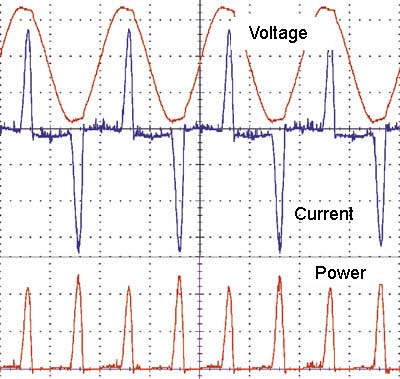 The measurement results were processed with a filter with the slope of -6 dB per decade and the cutoff frequency of 50 kHz at -3 dB; it made the measurements less precise (by 5-10%), but improved legibility of the oscillograms. At the same time short (less than 50 microsec) splashes and HF noise decreased markedly, sometimes disappeared. Such splashes arise either because of various pickups on sensitive parts of the measuring circuits or they exist in commutation and other circuits. The latter pickups can be suppressed quite effectively (more than by 40 dB) by input and output network filters located inside the UPSes and on the inputs of the pulse power supply units. The next allowance in the UPS tests that provided good resettability of results and released us from necessity to watch in which part of the period and in what time measurements are taken, was replacement of a power supply unit with a stable active load. We checked how the consumption character changes and arrived at the conclusion that it doesn't affect much power value and the shape. So, here are the parameters to be studied:
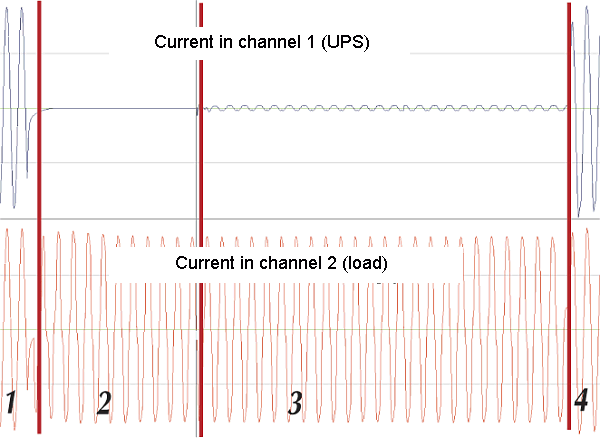 1. Power supplied. 2. No power supply. 3. Power supply is recovered. 4. Load gets line supply Note that the UPSes with the off-line and line-interactive (AVR) technologies have the transient period when switching to other operating modes (voltage stabilization, transition to the battery and back) from 4-5 to 10-15, and even 20-25 ms. For an On-line UPS such parameter as a switch time is not defined because the inverter(s) work(s) constantly after the unit is switched on irrespective of the line being on or off. The only thing that changes is that the inverter gets power from its own battery in the second case. So, on-line UPSes can provide the load with quality and reliable power supply irrespective of the mode (battery, line). We also looked at the shape of consumed current curve in the input circuit. In the most UPSes in the battery mode the current curve didn't look like a sinusoid, and in case of devices able to select charging current adaptively, it depended on the remaining change in the battery. GlossaryBefore we start our test will you have a quite look at the terms which will be often used in the article. It won't help you become an expert in 10 minutes in this sphere, but still, you will get a general idea on characteristics of the devices and how they influence their operation. Load. Load is the whole equipment consuming electric power. The main characteristics of the load are working supply voltage and consumed power. The UPS type we are dealing with is not for an electric kettle, a radiator or a laser printer which consumes in the toner fixing mode several kilowatts of power, while computers with monitors, telecommunication and other office equipment are a typical load for UPS. So, our UPS can be considered as a load for a town line, a diesel generator or another UPS of a firm power-supply system. Consumed power - this is a basic characteristic of any device regarding energy consumption. As a rule, it has an active component and a reactive one as with respect to the input such load can be considered consisting of an ideal fixed resistor and an element of reactive resistance. In some cases (for example, for pulse power supply units with a diode bridge and a capacitive filter on the input) it's hard to define an equivalent value of the reactive component of the complex impedance (for further analysis) as this value depends on an instantaneous current value, i.e. such load is a nonlinear circuit. Active power - this is useful power consumed by the load from the source which then proceeds for further conversion into another energy type (thermal, mechanical etc.). It is measured in Watts (W). Reactive power is not consumed from source. It accumulates in the load within a half-cycle and "turns" back during the next half-cycle without doing useful work but creating additional load on the power-supply system. There are special compensators to reduce it. If the reactive component of the power consumed, for example, by a big plant, exceeds the certain norm, the latter will have to pay penalty. It is measured in voltamperes reactive (VoA R). 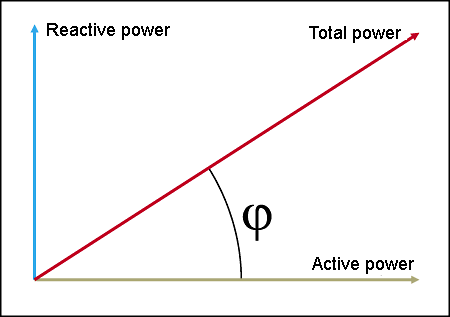 Total power is a vector sum of active and reactive powers. It is measured in voltamperes (VoA). Reactive power component defines a shift of the consumed power relative to voltage, but it doesn't influence the shape of consumed current (sinusoid), that is why voltage distortions it brings in are called linear. Load that consumes sinusoidal current is called linear. Electric heaters are an example of the linear load.  With only linear distortions on the diagrams the sinusoidal shape of oscillations remains but there is a phase shift of the definite angle between the current and voltage curves. In real life a load often brings in both linear and nonlinear distortions. As a rule, modern electronic equipment consumes non-sinusoidal current. Such load is called nonlinear, and distortions brought in are also nonlinear. The degree of harmonic distortions is characterized by the ratio of sum of high harmonics to the first harmonic - total harmonic distortions (THD) measured in percent. In case of an ideal sinusoid on the oscillograph's screen the THD is close to 0%; if distortions are noticeable THD =10%; for a rectangular shape THD=43%.  For complex estimation of distortions brought in by the load there is Power Factor which equals the ratio of active power (P, W) to total power (S, VoA) consumed by the load. A power factor below 0.8 is bad. For a computer load (i.e. for equipment of low power with its own pulse power supply units working from an AC line) PF makes about 0.7 and even better. But if the pulse power supply unit is designed without measures for increasing power factor, it can be lower 0.65 (i.e. like for usual full-wave rectifiers).  So, if there are only nonlinear distortions, PF is numerically equal to the first harmonic's share in the total power. In case of only harmonic distortions PF is equal to cos j (j - phase shift between current and voltage). Crest factor - ratio of the peak consumed current value to the average operating one. Its value depends on a shape of supply voltage. For sinusoidal voltage and linear load the crest factor is 1.4. But in case of sinusoidal supply voltage and computer load the crest factor grows up to 2-3. Sinusoidal voltage resulted from step-approximation on the same load usually gives crest factors from 1.4 to 1.9. All the characteristics mentioned above relate to the steady operating mode of the load. But you should account for transient processes which occur when the load modes change. Duration of the transient processes depends on a type of the device. Starting current characterizes load's consumption when it's just connected. About the standardsThe standard covering the UPS EN50091 has three parts. The first one (obligatory for products sold in EU) deals with security requirements. The second part (also obligatory) gives concepts and interpretations, and requirements for electromagnetic characteristics of UPSes. This part consists of two sections - radiation (allowable radiation of UPS into environment) and protection (allowable level of external radiation acting on UPS). The last part defines operating characteristics. It is not obligatory and sets control tasks for characterization of systems, provides the technique of measuring functional performance of various UPS types and formulates methods of specification for estimation of UPS. According to these standards, there are the following UPS types: 1. Stand-by Description of the devices and quality tests
[ Table of comparison characteristics of the UPSes ]APC Back-UPS CS BK325-RS, BK475-RS, BK350EI, BK500EI, BP500I
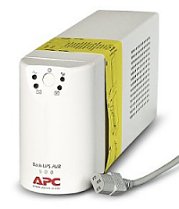 The CS series is produced for a long time and has given a good account of itself. The transition to the battery takes 2-5 ms. When shifting back to network which takes 1.3-3 ms the BK325-RS model has a noticeable inverter's swinging lasting almost 2.5 periods of the network frequency. We assumed that it's because the load power is too big (150W) for this UPS's inverter. The same was noticed in the transient process from the battery to network in case of the UPS BK475-RS. The BK350EI, BK500EI had nothing similar, that is why their circuitry differs from the above mentioned. The transient processes are 3-4.5 ms and nearly 2 ms long, repspectively. 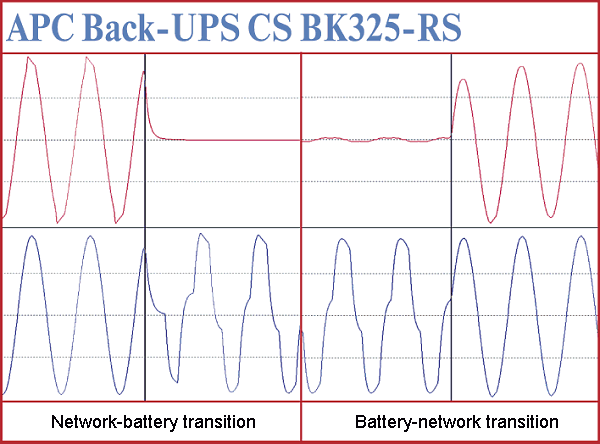 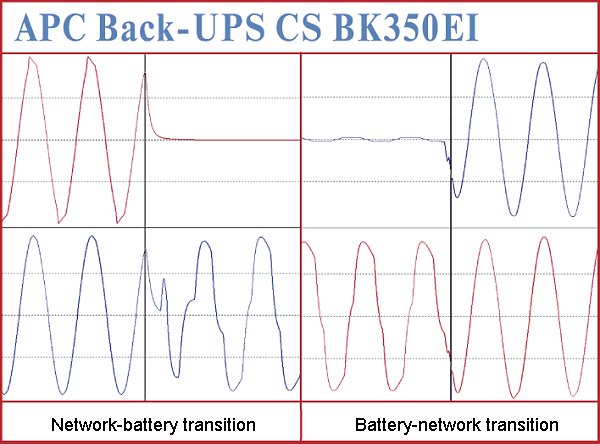  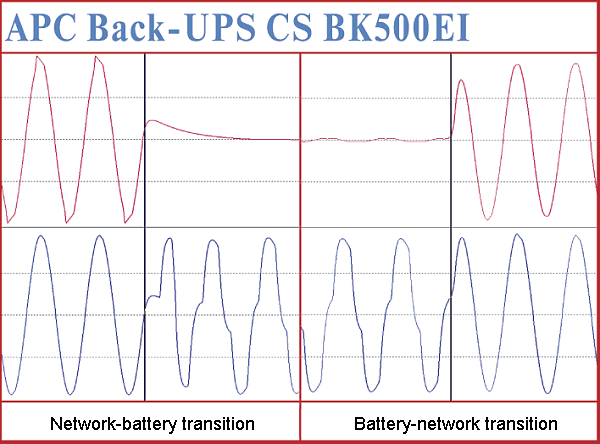 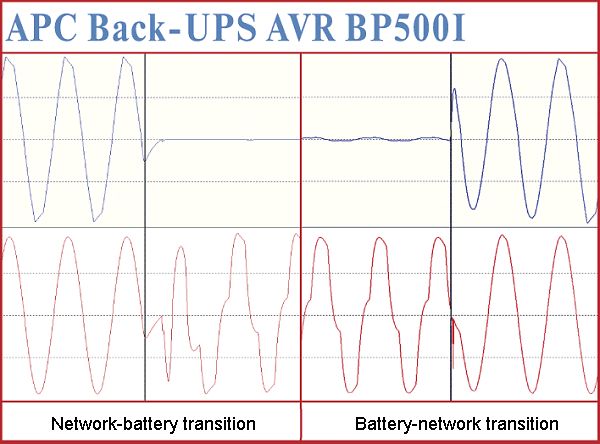 APC Back-UPS Pro BP650SI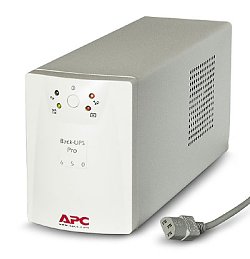 This series came to replace the Back-UPS CS and is designed to protect load in case of bad networks when previous UPSes constantly reswitched from network to battery or ignored unacceptable voltage reduction. The transition to battery takes 4 ms. The transient process to network lasts less than 1.8 ms. 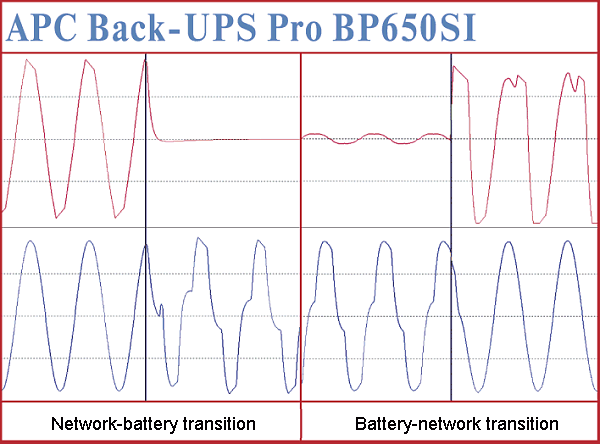 APC Smart-UPS On-Line SUOL1000XLI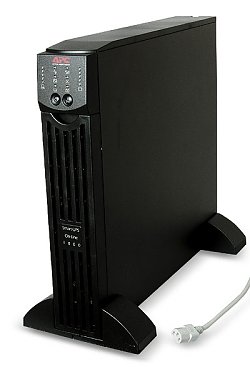 The APC Smart-UPS On-Line SUOL1000XLI model was first to be tested from the Smart-UPS series. This unit can be installed both on the rackmount and put on the floor for which there are two plastic supports. As we expected from the On-line UPS it has no reaction to lack of network voltage. It adjusted the phase very quickly. The process of current growing was quite entertaining when it shifted back from battery to network. 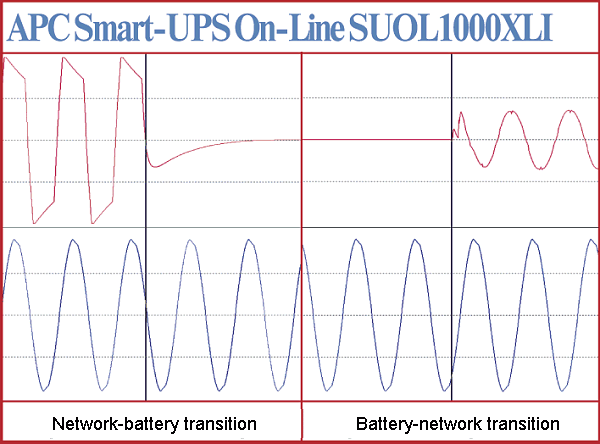 APC Smart-UPS SU420 INet, SU620 INet These models are the simplest in the APC Smart-UPS series. First of all, because of the rectangular output voltage when running from battery. The transition to battery takes 4-5 ms. It's quite difficult to define the return time - it takes a ot of time to prepare for both (over 1.3 s) but they finish quickly (less than 1 ms). 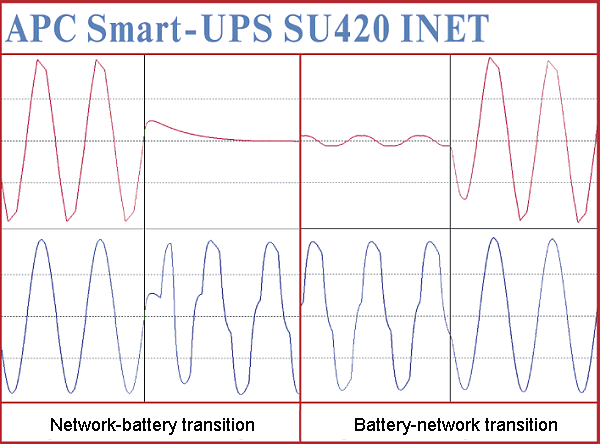
APC Smart-UPS SU700RMI2U, SUA1000I USB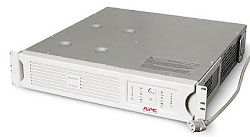
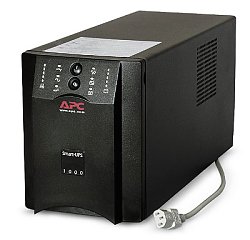 You should go with the SUA1000I if you want to control a UPS via USB. The reverse transitions are so smooth than one can hardly notice the beginning and the end. The maximum value is approximately 2 ms. The SUA700RMI2U is similar to the SUA1000I USB in character and duration of the back transition. 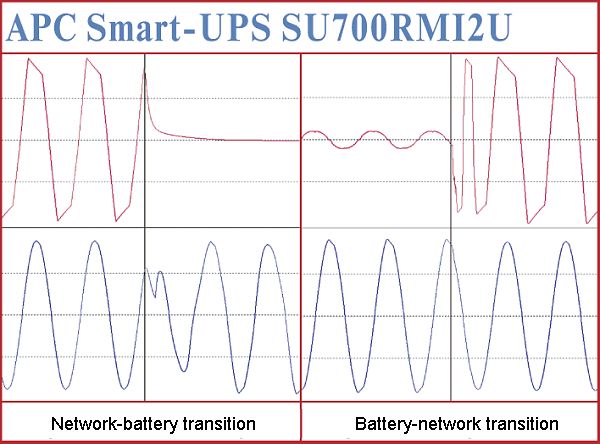
Apollo 1050E/500VA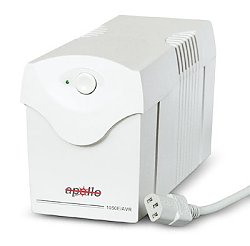 This AVR model has some unique properties. According to the oscillograms the input and output are somehow interconnected. At least, only this interconnection can explain the amplitude modulation at 3 Hz of the output voltage when the network gets on but the UPS hasn't switched the load to the network. This model is not very efficient - it took 4.3 s to "decide" whether to switch to the network or not. However, the transitions lasted only 6 ms (to battery) and 3 ms (back). 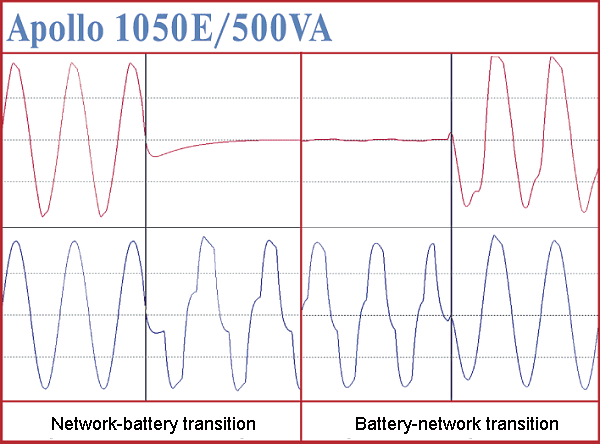 Apollo 1085A/850VA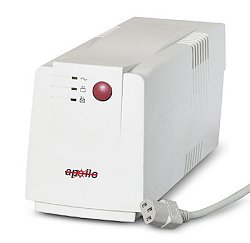 This model doesn't look like a brother of the above one at all. The Apollo 1085A has the output voltage in antiphase to the network one when working from the network. The transition to battery is very correct but not swift - 8 ms. The back transition to network lasts (when the input voltage is supplied) 1.24 s, but the transient process is quite lengthy - it finished in 9 ms; the reason is the same: before connecting the network it's necessary to disconnect the inverter from the output connectors and wait a bit for sure. In general, after we tested it in different modes we got an impression about it as a decent Asian solution for a home PC with a little overstated interter's power and quite tough (impulse) shape of consumed current. 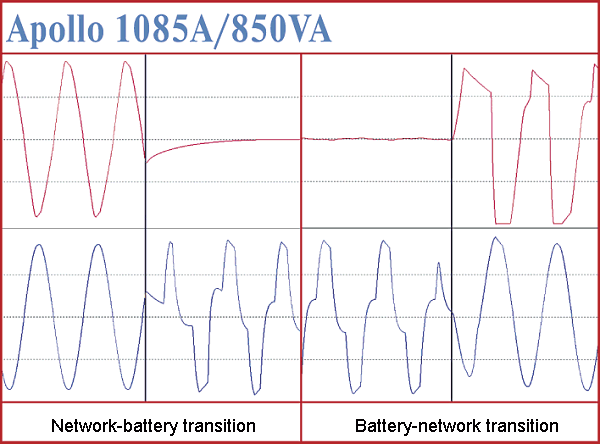 Gembird GSU-600VA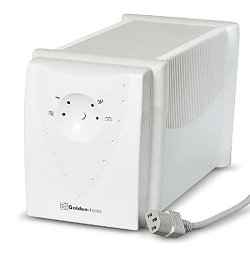 The DIP switch located behind allows choosing the lower switching threshold of 192, 182, 172 and 162 V. The transition depends on when (in which period) the network voltage was lost: the closer to the minimum, the longer the process. On average the inverter's startup time was 9 ms. The reverse process was very fast. But here the UPS looks original again - whatever the amplitude value of the network voltage can be when returning to the network, it is bound to 1/3-1/4 of the maximum amplitude value. As a result, the transient process ends in 4.7 ms at best. 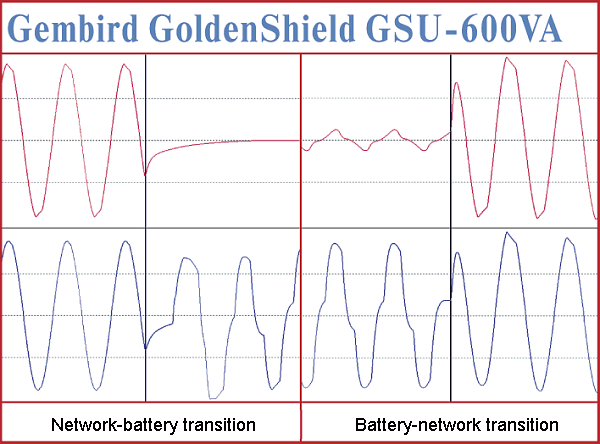 Liebert PowerSure PSPXT450-230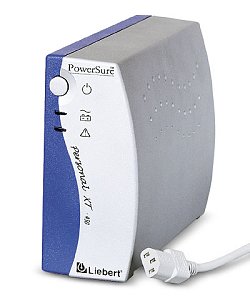 It took about 5 ms to shift from network to battery. When the power supply was recovered the UPS stopped for 1.5 s and then in 1 ms it connected the load to the network, though not very carefully. Well, this is a typical low-end UPS (in power and capacity) with decent characteristics. 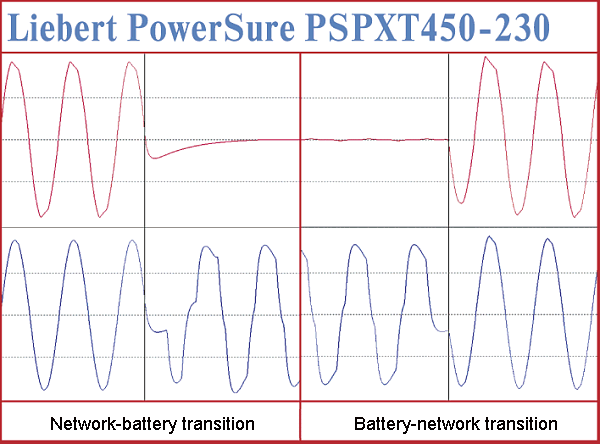 Liebert UPStation GXT 1000MT-230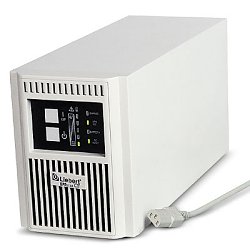 The manufacturer positions this UPS as a device for protection of file servers, workstations, telecommunication systems and other equipment (here are the advantages of an On-line UPS!) which have stronger requirements for quality of supply voltage. Being aware that the average error-free running time of this series is 100,000 hours we asked to give us a sample which is used a lot of time already. Later we found out that its parameters were so good and repeatable that we used it in adjusting the testbed. 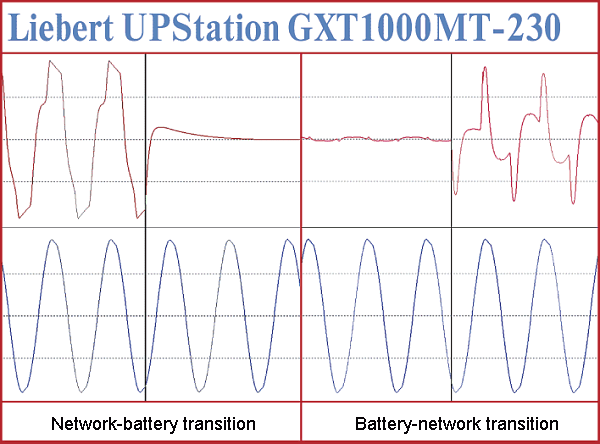 Mustek PowerMust 400VA Plus, 600VA Plus, 800VA Pro
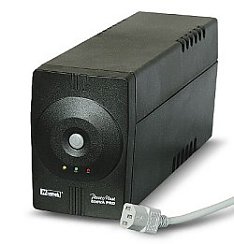 The transition back to the network is fast but not always entirely correct - far not at the moment when the supply voltage is zero. It can be on account of only its circuitry. The PowerMust 800VA Pro has it a little softer. 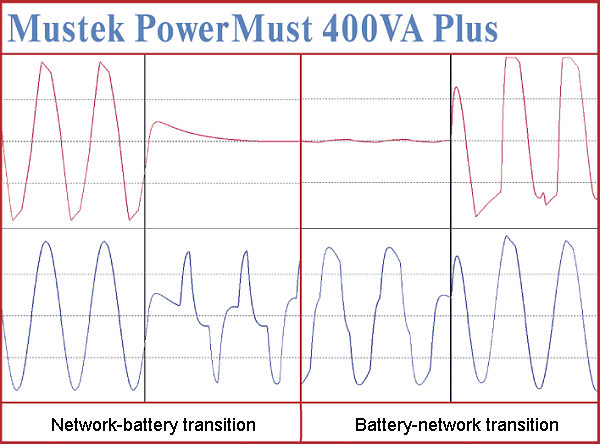
Powercom KIN-325A, 425AP, 525A, 625AP and BNT-400A, 600A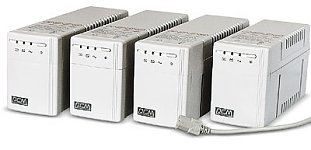
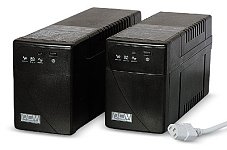 The BNT devices have no automatic charger, or rather, it's simplified and starts when power is supplied to the whole UPS. The KIN models have automatic recharge. The negative result of the system of autodiagnostics and battery test is shown on the indicator. Letters AP in the name mean that such model can be connected to the RS-232C port. I takes much time (up to 3 seconds) for all the devices to find out whether the network is recovered and operates stably. Such behavior can be interpreted differently: from slow and diffident to making solid, thought-out decisions... The devices are positioned as UPSes with an automatic voltage regulator (AVR). Total digital microprocessor control, automatic frequency selection (50/60 Hz). They are designed for protection of PC, workstations and other important equipment from main problems with power supply: high-voltage discharge, electromagnetic and radio frequency interference, increase, decrease and disappearance of voltage in the network. Cold start, protection of changes in voltage, from short circuit and overloads when the load gets power from battery. On the output the UPS has an approximated sinusoid. Well, the timing parameters of the transient processes of these UPSes are the "most average". It will be a good defender of your home entry-level computer. In case of the Powercom KIN-325A and BNT-400A, the time of reaction to loss of network together with the time of starting up the converter isn't great, it can be very different (3 times - from 3 to 8.5 ms) depending on the phase of the period when power is lost and on the load's power. 
Powercom KIN-1000AP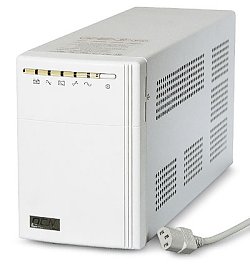 The KingPro series offers its Powercom KIN-1000AP model. 3 seconds to switch or not to switch... from the converter to the network... and it doesn't hit zero in course of the transition. As a result, it has 2-3 additional ms to finalize the transition. As for the shape of the output signal, the spectrum contains a relatively low level from the second to eleventh harmonics.  3-5-9 Powerware seriesThe products of the 3-5-9 series meet the requirements adapted for a wide range of users and complying with the CENELEC standards. Although the CENELEC norms help to choose a UPS, to understand them needs a certain level of professional knowledge. The 3-5-9 classification is used to simplify the choice. It divides all UPSes into three series, the first figure indicates the number of emergency situations a given UPS can handle:
Powerware PW3110 250i, PW3110 550i, PW3110 600i, PW3110 700i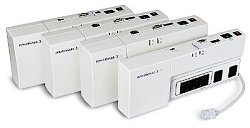 These UPSes look like twins and differ, at first glance, only in capacity of 12V batteries which makes 9 Aoh of the senior models (600i, 700i), 7.2 Aoh of the 500i and 4.2 Aoh of the junior one, which allowed the manufacturer to make the latter narrower by a third. The devices showed the same time of shifting to battery and back: 4-6 ms and 1.3 ms for the senior models and 2.5 and 3.2 ms respectively for the PW3110 250i. Note that the time and character of transition for the Off-line UPS is one of the best. 
Powerware PW5115 1000i, PW5115 750i, PW5115 500i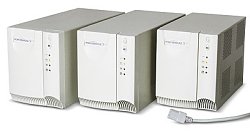 The oscillograms show the impulse character of current consumption from the network. But the output approximated sinusoid has no noticeable distortions. The working voltage is set with a DIP switch located on the back. The transition to battery lasts 4 ms. The time of back transition to network is hard to estimate as the switch process is so precisely bound to zero. But the time from voltage supply to actual reswitching (the load consumes current directly from network) hovers around 150 to 475 ms - this period is probably needed to reach the maximum synchronism of its own and network oscillations. 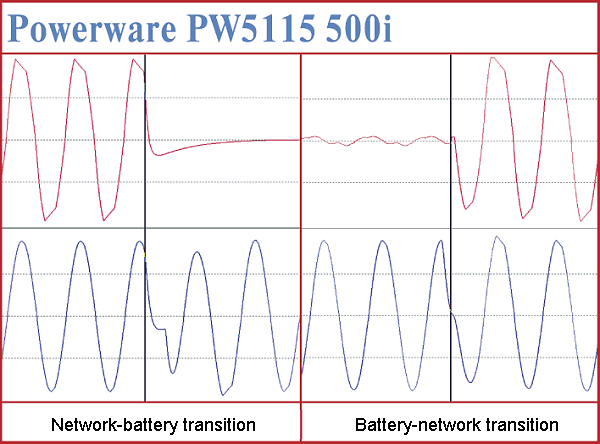
Powerware PW5125 1000i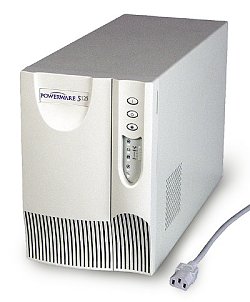 This is one of the latest models of line-interactive UPSes positioned for protection of office servers. Contrary to the PW5115 700i, the 1000i has no splashes on the transition diagrams. The time of switching to battery is low - 2 ms, and the decision to get back to the network was taken very quickly (610-620 ms); the shift back to network is also prompt (1.6-1.8 ms) and directly bound to zero of the network voltage. And the level of harmonics of the output voltage is unusually low. However, if you look at the run time of this device...  Powerware PW9120 1000i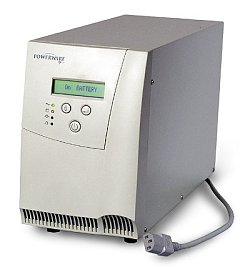 Once again I want to stress on advantages of the on-line devices, especially if you own a home theater with a big monitor. Simple management, constant monitoring of network and load parameters, everything is displayed on the backlit contrast LED monitor. The only thing that can hold you back from purchasing this unit is its price, though it's the lowest in its class. 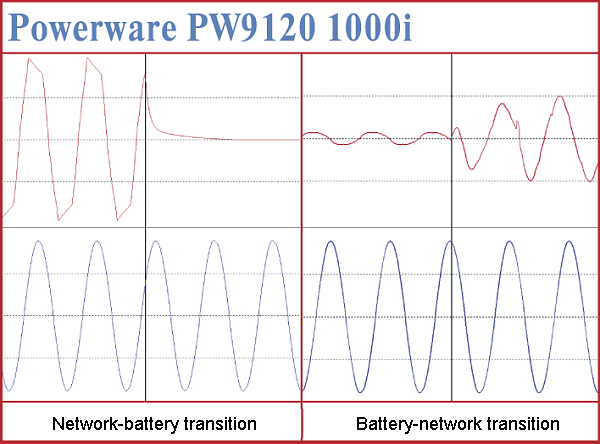 Trust Energy Protector AVR 650VA The high grade received in the duration tests doesn't match our impressions on operation of the definite sample on the test stand: when the network was cut off the device shifted to battery without problems (5 ms). But the reaction to network power recovery was very strange: first the UPS paused 2 sec, then gave 2-3 splashes in the consumed current and output channel. But it does work somehow... 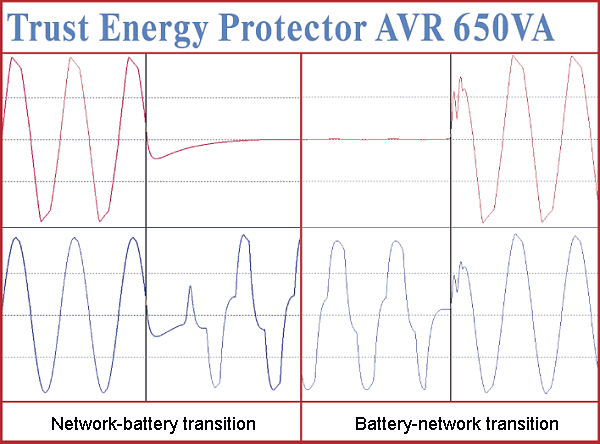 Battery running testsYour opinions have a great importance for us, and we do listen to logical and persistent critics. That is why, as you insisted, we replaced a reference load with two real systems (two PCs of the Bravo series provided by K-Trade). The first one is an average office computer: Celeron 1000 MHz, VIA PLE133T based board with an integrated graphics core, 128 MB PC133 SDRAM, 20 GB hard drive, 17" Samsung 753S monitor. The second is a more powerful desktop: Athlon XP 1800+, VIA KT266A based board, 256 MB PC2100 DDR SDRAM, 40 GB hard drive, GeForce4 MX440 based video card, 19" Samsung 959NF monitor. The testing technique is simple: we started the SYSmark 2000 (operation with the PAradox data base) on the computer running under the Windows 2000 Pro (SP3). This test uses actively the processor, video card and hard drive, that is why it is considered the most balanced benchmark. But before we turn directly to comments, let me explain you four categories of UPS regarding the operating time. Category # 1, or "quickly save your work and turn off the machine". The minimal safety degree, the time of operation with power off is up to 10 minutes. In most cases it's enough to let you save the results (let it be even a very big file or data base) and turn off the computer correctly. But you should do it right after the power cutoff. Category # 2, or "no panic". The time of operation is 10 to 20 minutes. During this period of time you can put into bookmarks opened interesting sites, write a short message and sent it by e-mail or ICQ notifying others about this problem, call the system administrator or technical director asking what might cause it, their forecasts etc. And only after that turn off the system. Category # 3, or "you have time to finish something". 20 to 30 minutes of running from battery. You might not hurry finishing your work. Probably you won't need to turn off the system at all if the power cutoff is promised to be short. Category # 4, or "just continue the work". Over 30 minutes. It's enough to finish rendering of a small scene or even write a small note or article. If such UPS is installed on the server, it will have time to notify the system administrator by SMS, who will also have time to come or find a way to switch off the machine using a remote control system. Small system, Category # 1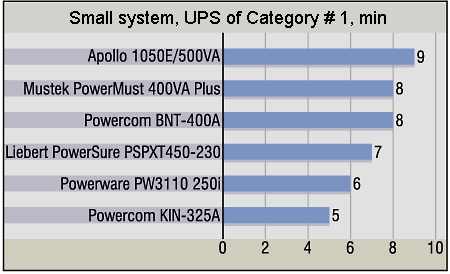 A simple, not very powerful computer, the first category... The solution is for those who want to save money. I would even say that for those who badly need protection from network failure but is cash-strapped. This group covers not very powerful and inexpensive UPSes. The Apollo 1050E/500VA is one of the best and cheapest. It's an obvious leader here. The Liebert PowerSure PSPXT450-230 should also be marked as it's very really minute, has a slick design but the price is also unique :). Small system, Category # 2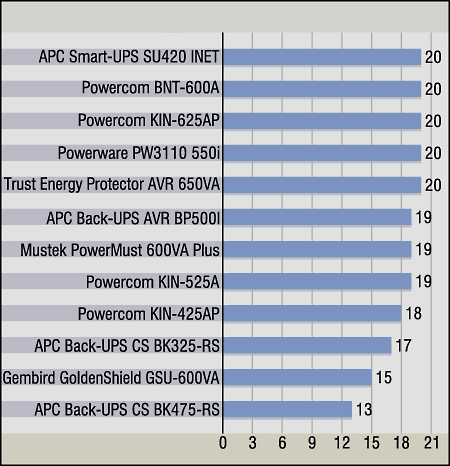 Here the range of prices and other properties is great: the operating time is 13 to 20 minutes, and price from $57 to $167. It's useless to define a leader as the devices are very different. The Powercom KIN-525A, Powercom BNT-600A and Trust Energy Protector AVR 650VA have the most optimal price/run-time ratio. The Mustek PowerMust 600VA Plus also provides less than $4 per minute. The APC Smart-UPS SU620 INET/SU420 INET are the most expensive, and the quality tests show why. The APC Back-UPS CS BK325-RS also belongs to this category. Rated at 325 VA and priced at $60 this device managed to provide 13 minutes of operation of our office computer! Small system, Category # 3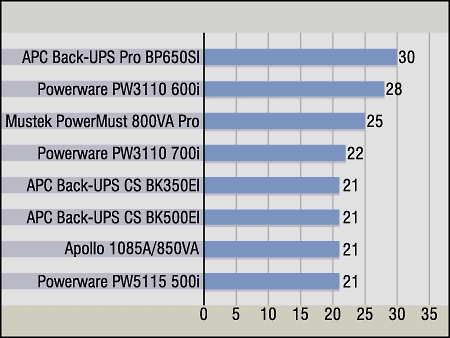 Over 20 minutes of running from battery. The Apollo's model also performs well as it has the cheapest minute. The price/run-time ratio is excellent of the APC Back-UPS CS BK475-RS and Mustek PowerMust 800VA Pro as well. The APC Back-UPS Pro BP650SI and Powerware PW3110 600i work longer than the rest. The first won 2 minutes, and it also provides more power. However, the Powerware's solution is cheaper by $60. Small system, Category # 4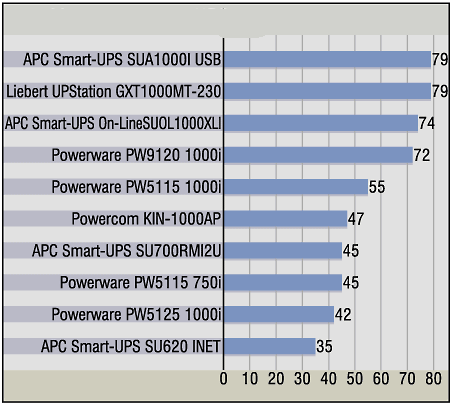 There is no competition at all. Firstly, all on-line UPSes are beyond it as they make a completely different class of devices. It's incorrect to compare the price/run-time ratios of on-line, line-interactive and off-line UPSes. Among the rest the leader is the APC Smart-UPS SUA1000I USB: at $380 you can get a device showing one of the best operating times. If you want something cheaper, then you can go with the Powercom KIN-1000AP - although it doesn't look extraordinary in the quality tests, it provides 47 minutes of operation at $185 (the only model in this group cheaper than $200). Big system, Category # 0It covers Apollo 1050E/500VA, Mustek PowerMust 400VA Plus, Powercom BNT-400A and KIN-325A, as well as Powerware PW3110 250i. Their results are lacking on the diagrams because they couldn't stand connection to the computer with high power consumption as the operating time is less than 1 minute. So, they are not for powerful computers. The Liebert PowerSure PSPXT450-230 and Powercom KIN-425AP can be described the same way: the fact that they are brought into the first category is not a recommendation for use but a "medal for heroism". Big system, Category # 1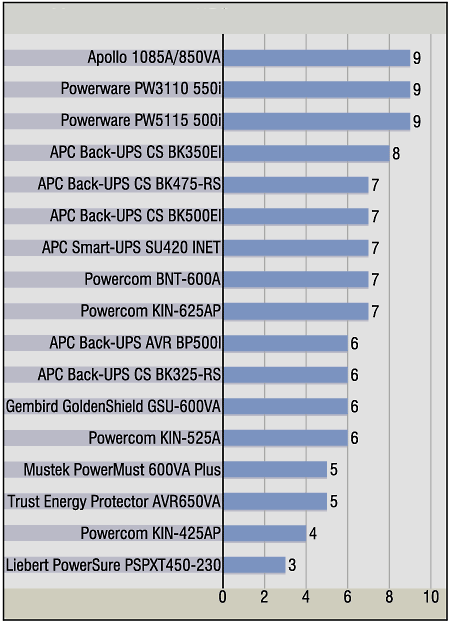 This group consists of a lot of models which can hardly be advised for powerful systems. Well, an owner of such configuration would hardly be so short of money that he could afford only something like APC Back-UPS CS BK325-RS - the device is good but not for such systems. That is why I would consider this diagram as a list of UPSes for small systems which proved again their positive qualities able to support a big computer. Big system, Categories # 2 and 3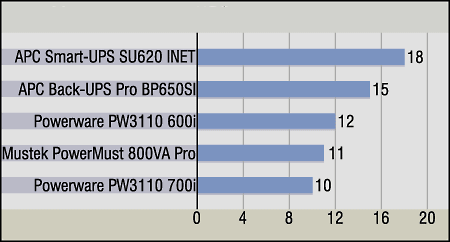  These are quite narrow groups which have almost no second-echelon manufacturers. Both diagrams are occupied by APC and Powerware, and only PowerMust 800VA Pro and KIN-1000AP from Mustek and Powercom respectively managed to get in here. The competition between Powerware and APC looks very interesting: in the second category two upper places are taken by the APC products and then goes Powerware, while in the third group it's vice versa: Powerware takes two first positions while APC is in the third one. It's a draw game. Big system, Category # 4 The On-line UPS rule. The scores are very close, that is why let's focus on the differences. If we compare scores of the 4th category in the small and big systems, we will see that the APC Smart-UPS On-Line SUOL1000XLI which used to be behind is far ahead now, while the Liebert UPStation GXT1000MT-230 has bent under the greater load. The APC Smart-UPS SUA1000I USB looks also perfect for its value. This is the only non-On-line UPS in this group, but the time and power make it competitive when On-line UPSes are not needed. ConclusionSo, today we examined the UPSes available on our local market from two standpoints: qualitative and quantitative. The first implies analysis of circuitry, how good the solution is in terms of its circuit design and correct functioning. In a word, it's what the developers are on account of when designing a certain product based on a hypothetic uninterruptible power supply unit the circuit of which can be drawn by any student of any electrotechnical university. The second approach, quantitative, is not just about elegancy of solutions or compliance with required parameters and standards, - it is a more practical approach, like how much is a minute with such UPS? So, in the first case, a solution is ideal when it optimally chooses an operating mode and a charging rate, gives an ideal sinusoid on the output, and when it's compact, reliable and elegant... How long it is going to work and how much a minute is going to be is not for us to answer. The crown of the second approach is a huge rechargeable battery for several thousands ampere-hours with an attached board with a simplest voltage changer and a couple of computer sockets, and the whole system should be cheaper than $100. It's not important that such monster can kill any connected device in half a year - the key thing is that it is able to provide hundreds of working hours even if power is cut off in the whole country. The balance between these two approaches is a distinguishing feature
of any UPS, and in this article we tried to focus on this balance. By and
large, everyone has its own opinion on which component should dominate
and what the ratio must be. That is why we tried to give you objective
information rather than recommend something.
Write a comment below. No registration needed!
|
Platform · Video · Multimedia · Mobile · Other || About us & Privacy policy · Twitter · Facebook Copyright © Byrds Research & Publishing, Ltd., 1997–2011. All rights reserved. |